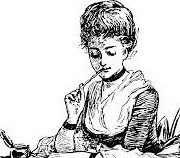MONTHLY BLOG 114, SELF-ISOLATION EIGHTEENTH-CENTURY STYLE
If citing, please kindly acknowledge copyright © Penelope J. Corfield (2020)

| Fig.1 Engraving (1808) of Lord Rokeby (1713-1800), a famous eighteenth-century self-isolator, who looked like a wise old wizard but whose actual message was obscure. |
It’s not original to note that humans are a highly social species. But it’s only now becoming generally appreciated just how damaging a period of prolonged and enforced isolation from others can be. Basically, it’s bad news for both physical and mental health.1 Of course, some individuals do embrace silence and seek solitude. Maybe for spiritual reasons. Yet such conscious choices, which can be revoked at any time, are very different from enforced solitude, not of an individual’s seeking.
The eighteenth century in Britain provided two quirky individuals who famously created their own isolated lifestyles, cushioned by their private incomes. So what can be learned from their stories? No great revelation of enlightenment emerges. Instead, the two men have been slotted into the history of zany English eccentricity.2 They certainly both fitted into that category plausibly enough. Yet do their lifestyles convey some further message for humanity in the early summer of today’s special virus-avoiding Lockdown?
One of these isolates was the well-connected Matthew Robinson, 2nd Baron Rokeby (1713-1800). He was a landowner, with legal training and literary interests. In his thirties (1747-61), he became MP for Canterbury. There was nothing to suggest his impending eccentricity. Anyhow, at a certain point, he developed a passion for daily immersion in water for hours on end. At first, he walked from his country estate near Hythe (Kent), on the edge of Romney Marsh, to swim in the sea, bathing for hours until he was exhausted and had to be rescued. Then he constructed a private pool in a glass-house attached to his country mansion, which he refused to heat. Again he stayed for hours in the water, refusing company. He got nourishment chiefly from an infusion of beef tea; refused to see doctors; and claimed that he could best worship naturally, in the water and under the stars. Occasional visitors were treated to readings of his lengthy poems.
When Rokeby (rarely) appeared in public, he was taken for a foreigner, on account of his flowing locks and massive beard. Anecdotes circulated about his lifestyle; and prints were engraved (as shown above), to illustrate his hirsute appearance. His younger sister, the highly sociable literary lady and bluestocking Mrs Montagu, wrote sardonically that her brother had become a modern Diogenes: ‘he flies the life of London, and leads a life of such privacy and seriousness as looks to the beholder like wisdom’.3 Ouch. Evidently his nearest and dearest were not impressed. His two younger sisters remained busy and productive: Elizabeth Montagu (1718-1800), later dubbed ‘Queen of the Blues’, and Sarah Scott (1723-95), the novelist and translator, whose Millennium Hall (1763) envisaged a harmonious community of women without men.4
For his part, Rokeby wrote and said nothing memorable, despite looking ever more like a wizard in his later years, He did not do anything to foster swimming or sea-bathing. His eccentric pastime remained a purely private matter, which ended only with his peaceful death in bed, unmarried and childless. His estate and the barony passed to a cousin.
What did all it mean? Rokeby’s lifestyle suggests a personal quest for ecological simplicity, before there was an ecological movement to join him or for him to join. He does not seem to have been personally unhappy; or, at any rate, did not announce any disquiet. Yet his story seems at very least to have been one of unrealised talents, particularly when contrasted with his siblings.
A second case of self-isolation was that of John Tallis (1675-1755). As reported in the Gentleman’s Magazine, he stayed in bed for the last 30 years of his life, swathed in coverings and with a peg on his nose, in a darkened, draught-proof room in a country inn at Burcot (Worcestershire).5 He saw no-one but a few occasional visitors, impelled by curiosity – and his servants, who replaced his bed annually.
Insofar as he justified his strange lifestyle choice, Tallis claimed, to general bemusement, that his morbid fear of fresh air was triggered by an old beldame’s curse. Evidently, he had sufficient funds to pay for his lodging and minimal keep. And no family intervened to try to change his mind. Throughout, Tallis declined to seek medical or even spiritual help for what seemed to be a prolonged and debilitating physical and/or psychological malady.
By the end of his life, he was becoming classed among the ranks of great British eccentrics. His sad tale probably provided the inspiration for William Wordsworth’s later ballad The True Story of Goody Blake and Harry Gill (1798). That jingling poem recounted a malediction directed at a wealthy but hard-hearted farmer, who had no compassion for a poor old woman gleaning in his hedgerow.6 His penalty for an icy heart was then to lie abed, forever chilled:
Oh! what’s the matter? what’s the matter?
What is’t that ails young Harry Gill?
That evermore his teeth they chatter,
Chatter, chatter, chatter still.
Of waistcoats Harry has no lack,
Good duffle grey, and flannel fine;
He has a blanket on his back,
And coats enough to smother nine.
Wordsworth’s imaginative evocation was much more vivid than anything communicated by Tallis, who gave no further explanation of his condition. The poet’s moral was that a flinty heart brought its own penalty. Property-owners should not begrudge the poor who gleaned in the fields and hedgerows, Wordsworth concluded pointedly.7
Tallis’s own inert self-isolation baffled everyone during his lifetime. Such a fatalistic belief in a personal curse already seemed like a relic of a bygone age, if that was indeed his motivation. It may simply have been an excuse for doing what he wanted, although his 30 year bed-rest did not seem very enjoyable. Certainly no witnesses to Tallis’s fate made any move to get him exorcised or the notional curse removed.
However, thanks to the transmuting power of poetry, this eccentric case of self-isolation prompted Wordsworth’s appeal for liberal warm-heartedness. ‘A-bed or up, by night or day;/ His teeth they chatter, chatter still,/ Now think, ye farmers all, I pray,/ Of Goody Blake and Harry Gill’. It’s always open to self-isolates to explain themselves to the wider world. But, if they don’t, then others will have a stab at doing so for them. After all, the moral is that isolates are not actually alone. The human community is watching, trying to detect a message.
ENDNOTES:
1 K.T. Rowe (ed.), Social Isolation, Participation and Impact upon Mental Health (New York, 2015); R. Fiorella, R. Morese and S. Palermo, Social Isolation: An Interdisciplinary View (2020).
2 J. Timbs, English Eccentrics and Eccentricities (1875); E. Sitwell, The English Eccentrics (1933); D. Long, English Country House Eccentrics (Stroud, 2012); S.D. Tucker, Great British Eccentrics (Stroud, 2015).
3 https://en.wikipedia.org/wiki/Matthew_Robinson,_2nd_Baron_Rokeby.
4 J. Busse, Mrs Montagu, Queen of the Blues (1928); S.H. Myers, The Bluestocking Circle: Women, Friendship and the Life of the Mind in Eighteenth-Century England (Oxford, 1990).
5 Gentleman’s Magazine (March 1753), p. 123.
6 J.A. Sharpe, A Fiery and Furious People: A History of Violence in England (2016), pp. 251-2.
7 W. Wordsworth, Poetical Works, ed. T. Hutchinson (1920), pp. 536-7.
For further discussion, see Twitter
To read other discussion-points, please click here
To download Monthly Blog 114 please click here










